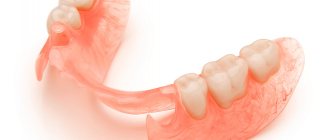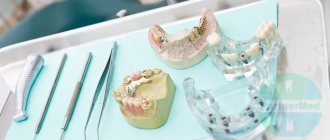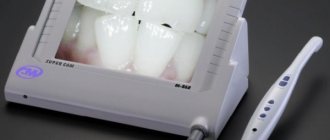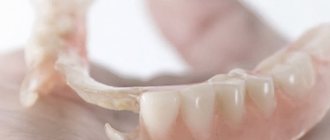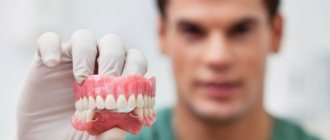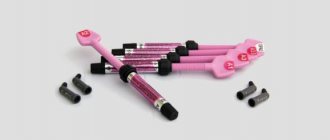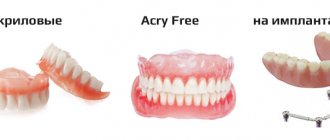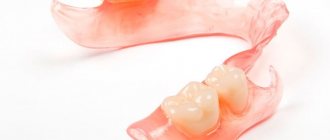1593
When a patient in a dental office is offered any type of prosthesis, the moment of choosing the material from which this structure will be made remains important.
Nowadays, clinic patients often prefer prostheses made of high-quality thermoplastic nylon. This material is used as a basis for Flexite designs.
General overview
Flexite are removable structures that have high functional and aesthetic qualities.
The main feature is the use of thermoplastic nylon . This material is highly biocompatible.
Also, its high plasticity and elasticity allows you to restore the functions of one unit or row of teeth to the maximum without discomfort.
This type of orthopedic structures is called new generation prostheses.
Flexite can produce different types:
- Microprostheses with clasps. It is this configuration that is used as an alternative to fixed structures, which are appropriate to be installed in areas with a small number of units.
Often these structures are used for adult patients who have systemic diseases, or for children who do not have molars. - Flexite partial plate dentures. If the patient has an end or included defect of varying length, then this type of prosthesis is installed.
This type of design helps to evenly distribute the load during the chewing process. Also, partial plate dentures are responsible for the stability of mobile teeth, which is important for people with gum disease.
There are quite a lot of individual types of Flexite, so the doctor can choose a system for each patient, taking into account the desires, capabilities and anatomical individuality.
The Flexite line of prostheses offers the following types:
- Plus. This option refers to universal systems because several types of material can be combined. The structures are characterized by good elasticity. Flexite plus is also endowed with low throughput against pathogenic substances.
- Supreme is a complete alternative to metal prosthetics, since the construction material is of medium rigidity. It can be used both for complete edentia and for restoring the function of a single tooth.
- Ultra - most often used for those patients who have various allergic reactions. The option with medium hardness is used for complete edentia.
- MP. This type of design is compared with Acry F acrylic systems. MPs are often installed on the entire dentition. It is characterized by high biocompatibility and repairability.
Choosing the exact type of orthopedic structure is a joint task of the doctor and the patient.
Clasp dentures with “locks”
Refers to conditionally removable dentures. They are distinguished by high aesthetics and great user convenience. According to the principles of fastening, such prostheses resemble bridges. This means that the chewing load is distributed evenly between the gingival surface of the jaw and the remaining teeth, unlike partial dentures, where the entire load falls on the gum. Also, the clasp denture is used as a splint for periodontal disease and increased tooth mobility.
A clasp denture is lightweight, takes up significantly less space in the mouth than a plate denture, which means it causes less inconvenience and requires less time to get used to. Such dentures need to be removed for only one purpose – cleaning.
Special “locks” (attachments) are placed into the prosthesis using high-precision devices, while the fastening is hidden inside the clasp prosthesis, which means that clasps and other metal structural elements are not visible from the outside.
The base plastic for a removable denture looks as natural as possible: now it is not just pink, but with an introduced vascular-capillary pattern, the teeth on the denture are indistinguishable from natural teeth.
Indications and contraindications
It is appropriate to install nylon systems for people with the following indications:
- In the absence of one tooth or an entire row of teeth.
- If you are allergic to metal alloys or polymers.
- In the presence of bruxism (teeth grinding).
- For periodontitis and periodontal disease.
The installation is also permissible for those persons for whom implantation is contraindicated. These include patients with epilepsy or patients with acute heart failure.
Installation of removable structures is contraindicated for people suffering from:
- Mental disorders.
- Diseases of bone tissue.
- Oncological diseases.
Before installing a prosthesis, you must warn your doctor about taking medications that may affect your blood.
When it is justified to reinforce the prosthesis and the material used.
Go here to learn more about the use of plaster in dentistry.
At this address https://www.vash-dentist.ru/protezirovanie/semnyie-p/protsedura-polirovki.html we will talk about the technique of polishing dentures.
In what cases are they used?
This type of thermoplastic is used in the manufacture of orthopedic and orthodontic dentures. It is also successfully used in structures where the simultaneous use of several types of materials is necessary.
Clasps are also made from this thermoplastic. These are fasteners that allow you to tightly fit the outer teeth near the gums themselves. For example, in other systems the clasps are metal, which negatively affects the aesthetic appearance. Also, thanks to the use of thermoplastic, the cost of a removable denture in the upper jaw will not be any different from that in the lower jaw.
Life time
The nature of the human body is such that over time, atrophy occurs not only of soft tissues, but also of bones. This leads to displacement of dental structures and their subsequent deformation. Although such processes exist, they take a long time. This allows Flexi Nylon dentures to last for more than 10 years.
However, like any other removable structure, dentures meet mandatory requirements. This guarantees use with constant loads for at least 3-4 years. In the future, rework or correction may be needed.
Indications and contraindications
Complete removable dentures for the upper jaw, as well as for the lower jaw, are universal. They are used to solve any problems where the use of denture structures is necessary:
- correction of the dentition. Partial dentures can discreetly replace one or more teeth;
- Can be used as a temporary structure;
- after jaw injuries of varying severity;
- Suitable for patients who are allergic to other denture materials.
Breakdowns and repairs
Frequent breakdowns include the following cases:
- damage to the base or the appearance of micro-scratches due to mechanical impact;
- loss of artificial teeth;
- damage to fixing clasps;
- weakened fixation on the gums.
Dentures are repaired only by specialists. For example, if an artificial tooth falls out, the attending physician will restore it to its original form. Scratches are removed by polishing, and tears are glued together with special adhesives.
If the damage is severe enough, the denture cannot be restored and the patient will be offered the option of replacing it. To do this, it will be necessary to go through all stages of prosthetics, starting from the formation of an impression and ending with installation.
Advantages
To understand the full value of the new generation of prostheses, you need to list the main advantages of the structures:
- High elasticity. Due to this property, doctors are able to reduce the load that falls on the supporting teeth.
- Small weight and dimensions. Convenient and comfortable designs allow you to speed up the process of adaptation, since the designs do not particularly interfere with talking or chewing food.
- Automatic balancing. After installation, the structure is able to independently adapt to the slightest anatomical changes in the jaw, which is convenient for the patient.
- Tight fit and minimal shrinkage can significantly extend the life of structures.
- Strength of the material. Patients now have the opportunity not to limit themselves in the choice of food products regarding hardness. The material also has excellent resistance to chemicals.
- High-quality fixation. Regardless of the chosen type of fixation, the product is securely held in the patient’s mouth.
- There is no need to grind down the supporting teeth. To fix the products, there is no need to prepare adjacent units or install additional crowns.
- Aesthetics. The product imitates the anatomical elements of the dentition, which is not only convenient, but also aesthetically pleasing. A person feels more confident and comfortable.
After installing Flexite, the patient will get used to the system within 1-2 weeks, which will speed up the full functioning of the jaws.
Flaws
Many doctors argue that nylon prostheses are considered temporary rather than permanent.
They are not recommended to be worn for a long time, as atrophy of the alveolar process is possible. The main disadvantages of such prostheses:
- Possibility of modification of the material due to the use of too hot food;
- Possibility of gum rubbing in the area of fixation.
- Point load. The alveolar ridge of the oral cavity may atrophy.
- High price . Not all patients can afford Flexite dentures, so it is important to select designs together with your doctor, taking into account all factors.
- Difficulties in care . The material is elastic and hygroscopic, so it may not always retain its original properties after ingesting coloring food.
Before choosing any design, you need to weigh all its pros and cons, based on the advice of your doctor.
The secret of the popularity of the Ivoclar removable denture is the material used for its manufacture.
In this publication we will talk about the features of the classification of toothless jaws according to Keller.
Here https://www.vash-dentist.ru/protezirovanie/semnyie-p/perebazirovki.html all the most important things about relining a removable denture.
Advantages and disadvantages of acetal dentures
As can be understood from the name of the prostheses, they are made using injection molding material – acetal plastic. This material demonstrates exceptional strength properties. Products made from it have an incredibly attractive appearance. Acetal plastic does not provoke allergic reactions and is easy to clean and treat with oral care products. As a rule, the material is most often used for the production of clasp dentures.
A few words about the advantages of acetal dentures:
- As mentioned above, this material is hypoallergenic and does not cause rejection. The patient adapts to them extremely quickly. The compatibility of acetal products with the body has been proven.
- Plasticity and strength of prostheses. As a rule, dentures made from this material fail only if force is exerted to break them. When used as intended, they are incredibly durable.
- Material hygiene. The material is easy to clean traditionally, and dentures can be treated with traditional oral care products. Acetal is neutral to natural dyes and flavors. He doesn't pick up their smells.
- Extremely comfortable dentures. The patient has no adaptation period at all. Since products made from acetal do not put pressure on the gums, they do not injure the mucous membrane, tongue, or teeth. Clasp retainers do not put pressure on the teeth and do not damage the enamel.
The disadvantages of such products include the fact that compared to nylon, they have greater transparency. Because of this, teeth may not look natural. Nylon dentures have a more natural appearance. Prostheses of the second type require additional fixing means.
As mentioned above, any prosthesis negatively affects the condition of bone tissue. Acetal dentures are no exception here and, over time, they need to be adjusted.
To decide which prosthesis is best, we recommend analyzing the following characteristics:
- Both types of dentures do not require grinding of teeth;
- Nylon and acetal do not provoke allergies;
- The strength of the two types of materials is the same;
- Nylon dentures change color over time, acetal dentures do not;
- Nylon prostheses are 30% cheaper than acetal ones. But, at first, stone deposits are possible.
How to avoid problems?
Wearing comfort, functionality and service life depend on the correct selection of design.
To avoid problems, you need to discuss all the details with your doctor. His advice and recommendations should be based not only on theory, but also on practice, so it is important to choose a qualified specialist.
When choosing a device, it is important to discuss several points:
- Type of prosthesis.
- Degree of hardness.
- Material color.
- Shrinkage percentage.
- Rules of care.
The patient must understand what design awaits him, therefore, if possible, the doctor should clearly show the selected option.
Dental prosthetics in Minsk
The StomLand clinic provides all types of dental prosthetics in Minsk, prosthetics on implants according to the protocol all on 4 “all on 4”, all on 6 “all on 6”, all on 8 “all on 8”, clasp prosthetics, plastic prosthetics butterfly, prosthetics for complete and partial absence of teeth, etc. Prosthetics can take from 7 to 10 days. Expedited prosthetics for non-residents is possible; the timing is individually agreed with the doctor.
Manufacturing
Nylon orthopedic systems for prosthetics are produced in two stages. The first is a complete examination of the oral cavity and treatment of existing pathologies. If there are teeth that cannot be treated, they need to be removed.
After treatment, you can proceed to the second stage. It includes the following points:
- Making impressions of the patient's jaw.
- Transporting the impression to the laboratory.
- Casting a model of the patient's jaw from plaster.
- Nylon is poured into the wax model, which follows the contours of the cast.
- Preliminary fitting.
- Approval of the color and shape of the resulting prosthesis.
If all the nuances have been discussed and approved, then the model is sent for final formation. Directly in the dental laboratory, specialists carry out the following activities:
- After casting the model, the boundaries of the prosthesis are applied to it with a special chemical pencil.
- These boundaries are trimmed with wax.
- The technician performs the final modeling.
- After using the thermostat, the prosthesis becomes strong, but its surface remains rough.
- The denture is polished.
Creating any type of structure has its own nuances, so it is important to fulfill all technological requirements. The work must only be carried out by a qualified specialist.
The video shows the basic manufacturing process of the Flexite prosthesis.
Stages of creation
Before a structure is installed on a patient, it must go through several manufacturing stages:
- A dental examination includes the complete elimination of damage to dental tissues and treatment of the oral mucosa.
- Taking impressions. To do this, use an alginate mass, which is placed in prepared spoons for the procedure. The advantages of the mass used are that it does not exert excessive pressure on the mucous membrane and gives the most accurate indicators.
- Making an auxiliary plaster model in the laboratory using casts.
- Applying wax to the model in the places where the clasps are placed and on the front teeth.
- Creating a duplicate of the model using dental silicone. This design is an exact copy of the future prosthesis, and all procedures up to the processing stage will be performed on it.
- Plastering the model in the articulator.
- Layout of the prosthesis - it should cover the entire part of the mucous membrane, without touching the moving parts of the jaw.
The nylon prosthesis occupies a minimum area on the palatal surfaces, while maintaining the best functional qualities. At this stage, it is important to ensure that the border of the prosthesis continues the shape of the teeth and is identical to the structure of the oral cavity. - Selection and installation of artificial teeth.
- Plastering of the resulting models in ditches. After the gypsum has hardened, the containers are placed in hot water and the wax is evaporated from them.
- Unwinding the cuvettes and removing wax residues.
- Installing a nylon cartridge into a heat press.
- Indication of parameters for injection (the process of injecting nylon heated to 250 degrees into a mold). Temperature, pressure, injection speed, manufacturing and cooling time are set.
- Immerse the cuvettes in cold water until completely cooled. After this, the opening takes place, the plaster is removed and the manufactured prosthesis is removed.
- Cleaning the structure with a cutter to remove gypsum residues and roughness.
- Polishing. Produced on grinding machines using special pastes. Effective and fast polishing is achieved thanks to the density of nylon fibers.
The process of making the prosthesis can be seen in the video.
Care instructions
To ensure that the design does not lose its aesthetic and functional properties, it is necessary to ensure proper care of the prosthesis itself and the patient’s oral cavity:
- After eating, always remove and wash the denture;
- Clean the structure with a special professional paste that will fight pigmentation;
- Rinse the system with an irrigator for disinfection 2 times in 7 days;
- Visit your dentist every 6 months for professional cleaning;
- You cannot leave the structure for a long time without a special storage liquid;
- Correction is carried out on a regular basis according to the doctor’s recommendations.
It is contraindicated to carry out correction on your own, as you can damage the prosthesis. For any changes you should visit a doctor. This is especially true for cases with chips or cracks.
How much do nylon dentures cost?
The cost of flexible partial dentures can vary greatly depending on the many different elements that need to be taken into account.
First of all, this is the specialist level: usually prosthetists charge more than general dentists because their level of training is higher. Secondly, the location of the dental clinic. Prices in Moscow will be higher than in St. Petersburg. The price also depends on how many teeth you need to replace. Replacing front teeth may be less affordable because you want to achieve an aesthetic result.
If you require tooth root extraction or oral surgery to realign a bone ridge, the final price you will have to pay increases.
Reviews
The installation of such orthopedic systems is quite common, so if you have something to share with us, we will be glad to see your feedback.
If you find an error, please select a piece of text and press Ctrl+Enter.
Tags Flexite dentures nylon dentures removable dentures
Did you like the article? stay tuned
Previous article
Review and scope of nanocomposites in dentistry
Next article
Temporary abutment is an important link in aesthetic prosthetics
